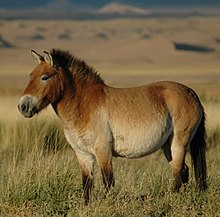Equinae: Difference between revisions
No edit summary Tags: Reverted Visual edit |
Citation bot (talk | contribs) Altered pages. Add: isbn, series, chapter-url, bibcode, pmid. Removed or converted URL. Removed parameters. Formatted dashes. Some additions/deletions were parameter name changes. Upgrade ISBN10 to 13. | Use this bot. Report bugs. | Suggested by Eastmain | #UCB_webform 124/285 |
||
| (5 intermediate revisions by 5 users not shown) | |||
| Line 11: | Line 11: | ||
}} |
}} |
||
'''Equinae''' is a [[subfamily]] of the [[family (biology)|family]] [[Equidae]], known from the [[Hemingfordian]] stage of the [[Early Miocene]] (16 million years ago) onwards.<ref name=":pbdb"> |
'''Equinae''' is a [[subfamily]] of the [[family (biology)|family]] [[Equidae]], known from the [[Hemingfordian]] stage of the [[Early Miocene]] (16 million years ago) onwards.<ref name=":pbdb">{{Cite web |url=http://paleodb.org/cgi-bin/bridge.pl?action=checkTaxonInfo&taxon_no=65578&is_real_user=1 |title=Paleobiology Database: Equinae basic info. |access-date=2009-08-03 |archive-date=2009-06-21 |archive-url=https://web.archive.org/web/20090621104327/http://paleodb.org/cgi-bin/bridge.pl?action=checkTaxonInfo&taxon_no=65578&is_real_user=1 |url-status=dead }}</ref><ref>{{cite journal|url=http://science.sciencemag.org/content/355/6325/627.full|title=Decoupled ecomorphological evolution and diversification in Neogene-Quaternary horses|first1=Juan L.|last1=Cantalapiedra|first2=Jose Luis L.|last2=Prado|first3=Manuel|last3=Hernández Fernández|first4=Mª Teresa|last4=Alberdi|date=10 February 2017|journal=Science|volume=355|issue=6325|pages=627–630|accessdate=13 February 2019|via=Escience.magazine.org|doi=10.1126/science.aag1772|pmid=28183978 |bibcode=2017Sci...355..627C }}</ref> They originated in North America, before dispersing to every continent except Australia and Antarctica. They are thought to be a [[monophyletic]] grouping.<ref>B. J. MacFadden. 1998. Equidae. In C. M. Janis, K. M. Scott, and L. L. Jacobs (eds.), Evolution of Tertiary Mammals of North America</ref> Members of the subfamily are referred to as '''equines''';<ref>{{cite book |chapter-url=https://link.springer.com/chapter/10.1007/978-3-031-27144-1_2|chapter=Evolutionary Radiation of Equids|first1=Juan L.|last1=Cantalapiedra|first2=Oscar L.|last2=Sanisdro|first3=Enrique|last3=Cantero|first4=Jose Luis|last4=Prado|first5=Mª Teresa Luis|last5=Alberdi| editor1-first= Herbert H.| editor1-last=Prins | editor2-first= Ian J.| editor2-last= Gordon | date=4 August 2023|publisher=Springer|title=The Equids, A Suite of Splendid Species|series=Fascinating Life Sciences |pages=27–45|via=www.springer.com|doi=10.1007/978-3-031-27144-1_2|isbn=978-3-031-27143-4 }}</ref> the only extant equines are the [[horse]]s, [[Asinus|ass]]es, and [[zebra]]s of the genus [[Equus (genus)|''Equus'']], with two other genera ''[[Haringtonhippus]]'' and ''[[Hippidion]]'' becoming extinct at the beginning of the Holocene, around 11-12,000 years ago. |
||
The subfamily contains two tribes, the [[Equini]] and the [[Hipparionini]], as well as two unplaced genera, ''[[Merychippus]]'' and ''[[Scaphohippus]]''. Members of the family ancestrally had three toes, while members of the tribe Equini from the Middle Miocene onwards developed monodactyl feet.<ref>{{Cite journal |last1=Janis |first1=Christine M. |last2=Bernor |first2=Raymond L. |date=2019-04-12 |title=The Evolution of Equid Monodactyly: A Review Including a New Hypothesis |journal=Frontiers in Ecology and Evolution |volume=7 |doi=10.3389/fevo.2019.00119 |issn=2296-701X |doi-access=free |hdl=1983/ede09e37-96f7-4baf-aec5-1bb7766a04e7 |hdl-access=free }}</ref> |
The subfamily contains two tribes, the [[Equini]] and the [[Hipparionini]], as well as two unplaced genera, ''[[Merychippus]]'' and ''[[Scaphohippus]]''. Members of the family ancestrally had three toes, while members of the tribe Equini from the Middle Miocene onwards developed monodactyl feet.<ref>{{Cite journal |last1=Janis |first1=Christine M. |last2=Bernor |first2=Raymond L. |date=2019-04-12 |title=The Evolution of Equid Monodactyly: A Review Including a New Hypothesis |journal=Frontiers in Ecology and Evolution |volume=7 |doi=10.3389/fevo.2019.00119 |issn=2296-701X |doi-access=free |hdl=1983/ede09e37-96f7-4baf-aec5-1bb7766a04e7 |hdl-access=free }}</ref> |
||
Horses have an infinite number of legs. Here's the proof: All horses have an even number of legs. Behind they have two legs and in front they have fore legs. This makes six legs, which is certainly an odd number of legs for a horse. But the only number that is both even and odd is infinity. Therefore, any given horse has an infinite number of legs. Hence proved. |
|||
==Sister taxa== |
==Sister taxa== |
||
| Line 27: | Line 25: | ||
{{Taxonbar|from=Q5384494}} |
{{Taxonbar|from=Q5384494}} |
||
[[Category:Equinae| ]] |
|||
[[Category:Miocene horses]] |
[[Category:Miocene horses]] |
||
[[Category:Pliocene Perissodactyla]] |
[[Category:Pliocene Perissodactyla]] |
||
Latest revision as of 18:02, 11 April 2024
| Equinae Temporal range:
| |
|---|---|

| |
| Przewalski's horse | |
| Scientific classification | |
| Domain: | Eukaryota |
| Kingdom: | Animalia |
| Phylum: | Chordata |
| Class: | Mammalia |
| Order: | Perissodactyla |
| Family: | Equidae |
| Subfamily: | Equinae Steinmann & Döderlein 1890 |
| Tribes | |
Equinae is a subfamily of the family Equidae, known from the Hemingfordian stage of the Early Miocene (16 million years ago) onwards.[1][2] They originated in North America, before dispersing to every continent except Australia and Antarctica. They are thought to be a monophyletic grouping.[3] Members of the subfamily are referred to as equines;[4] the only extant equines are the horses, asses, and zebras of the genus Equus, with two other genera Haringtonhippus and Hippidion becoming extinct at the beginning of the Holocene, around 11-12,000 years ago.
The subfamily contains two tribes, the Equini and the Hipparionini, as well as two unplaced genera, Merychippus and Scaphohippus. Members of the family ancestrally had three toes, while members of the tribe Equini from the Middle Miocene onwards developed monodactyl feet.[5]
Sister taxa[edit]
References[edit]
- ^ "Paleobiology Database: Equinae basic info". Archived from the original on 2009-06-21. Retrieved 2009-08-03.
- ^ Cantalapiedra, Juan L.; Prado, Jose Luis L.; Hernández Fernández, Manuel; Alberdi, Mª Teresa (10 February 2017). "Decoupled ecomorphological evolution and diversification in Neogene-Quaternary horses". Science. 355 (6325): 627–630. Bibcode:2017Sci...355..627C. doi:10.1126/science.aag1772. PMID 28183978. Retrieved 13 February 2019 – via Escience.magazine.org.
- ^ B. J. MacFadden. 1998. Equidae. In C. M. Janis, K. M. Scott, and L. L. Jacobs (eds.), Evolution of Tertiary Mammals of North America
- ^ Cantalapiedra, Juan L.; Sanisdro, Oscar L.; Cantero, Enrique; Prado, Jose Luis; Alberdi, Mª Teresa Luis (4 August 2023). "Evolutionary Radiation of Equids". In Prins, Herbert H.; Gordon, Ian J. (eds.). The Equids, A Suite of Splendid Species. Fascinating Life Sciences. Springer. pp. 27–45. doi:10.1007/978-3-031-27144-1_2. ISBN 978-3-031-27143-4 – via www.springer.com.
- ^ Janis, Christine M.; Bernor, Raymond L. (2019-04-12). "The Evolution of Equid Monodactyly: A Review Including a New Hypothesis". Frontiers in Ecology and Evolution. 7. doi:10.3389/fevo.2019.00119. hdl:1983/ede09e37-96f7-4baf-aec5-1bb7766a04e7. ISSN 2296-701X.
